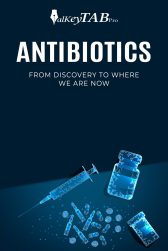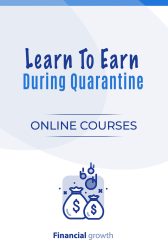Wishlist
Titles you like
$3.99

About Book
Antibiotics are weapons used against bacterial infections that have existed for millennia. The history of the first use of natural antibiotics was a long time ago, but the name and our common usage are only a little more than a century old.
Discover the world of antibiotics and how we came to understand how useful the natural components could be to help eradicate known diseases. Once you understand the past, you can view the present, how we arrived at the common antibiotics, their classes and types, and how to administer antibiotics.
You will discover that not all countries use the same names or classes, and some places do not have access to the synthetic and semisynthetic antibiotics we use in Western cultures.
Antibiotics are helpful for several bacterial infections, but they also have cautionary tales. Research studies indicate certain antibiotics can have significant side effects, called adverse reactions, including allergic reactions. Sometimes it is a combination of two antibiotics together, and at other times it is the person’s individual reaction.
By the end, you will understand:
• What an antibiotic is
• Who discovered it
• How antibiotics were discovered
• When they were found
• Where antibiotics are from or how they are created
• How they are used and administered
• The future of antibiotics
• How they have changed the course of history
You are also going to learn about adverse reactions, including antibiotic resistance that drug companies and physicians are dealing with now and will be dealing with in the future. You will come away from this lesson with an understanding of the future of antibiotics.
The future right now may be bleak when examining the current situation, but there are many hopeful researchers who wish to see antibiotic resistance lowered and new medications on the market when there have been none for decades. Antibiotics save us from deadly diseases and acute and chronic illnesses, but sometimes do not work for patients, which makes the entire story fascinating.
$3.99

The Scientific Method
- Item added
- by admin
About Book
Understanding the world around us has always been a fundamental part of human development. We are, by nature, a curious species, and will stop at nothing to make sense of the world around us. The mysteries need to be unraveled, truths be told, and lessons learned.
This innate need to understand is what has given rise to many ancient religions, lore and legends, and deep-seated cultural beliefs. And with the advancement of technology and everyday discoveries, these have slowly given way to discoveries based on a hypothesis, observation, investigation and results.
Over the years, man has come to rely on science to explain the unknown. And at the center of this is the scientific method. It is the fundamental basis upon which scientific discoveries are built.
In this book, we introduce you to the scientific method, how it has developed over the years, and how it is being applied to everyday life. This book explains the reason behind the scientific method’s importance and how you can best utilize it to make sound observations and conclusions.
In a short read, you will definitely come out of this with a lot more than when going in, and you’ll be armed with a weapon the greats have used for centuries to make the world what it is today! With this simple method, you’ll can become an expert at making decisions. Go and ahead and make an important decision now by adding this book to your cart!
$3.99

The Scientific Method
- Item added
- by admin
$5.99

About Book
This book will change the way you think about and use water. Water is life. Without it, life as we know it would not exist on Earth. As you read on you will discover:
● The major reasons why water is becoming scarce.
● The prognosis if we don't make rapid and substantial changes.
● How water scarcity is already harming the poorest communities on the planet.
● How the environment is being damaged.
● How close we are to passing a point of no return.
Though much of what you will read may be shocking, there is still room for hope and a narrow window of time during which we can change course. There are things that we can do, but it is going to take a sustained effort. The book will look at what changes are being made and can be made at both a macro and micro level.
● Small steps can take us a long way.
● Education is crucial.
● Technology is moving fast and in positive directions.
● International action needs us to motivate it.
● We can learn to reduce our consumption.
As you read through the book, you will probably feel like you are on a bit of a roller coaster ride. A journey in which things at first appear to be totally gloomy but eventually culminate in a turnaround, providing we act fast. Change has to happen, and reading this book is going to demonstrate that in ways that are difficult to deny. The good news is that we can be a part of that change and, indeed, we must.
This may be one of the most important books you ever read. Don’t delay.
$3.99

Lead Generation
- Item added
- by admin
About Book
Are you feeling confused about how to grow your business? Have you failed to understand why your business is not picking up? Have you heard about lead generation from your peers, but are scared to try it? Then you have made the right choice as this book will solve all your questions regarding lead generation.
Every business owner wants his or her business to succeed. They are always on the lookout to find good techniques and tips that can help their business to grow. Lead generation can really help your business to grow if you know what and how to do it. This book contains many lead generation tactics along with the basics of lead generation, which will help you become an expert in no time.
It is crucial to understand why lead generation is important and how it can transform your business from a startup or an average business to a grand success. To help you on this journey, this book will serve as a guide that will help you overcome all your obstacles and transform your audience into regular customers.
In the course of this book, you will discover about things such as:
- What are leads?
- What are quality leads?
- Different types of leads
- What is lead generation?
- How does lead generation work?
- How can lead generation help you?
- Strategies that will help you get the best leads
- Great ideas for lead generation
- Techniques to get quality leads
So what are you waiting for? Click on the buy now button and take your first step towards getting fresh and quality leads!
Summary
Lead generation is a great way to generate profit for your small or large scale business. It provides a brilliant opportunity for people who want to grow their database and develop their business. It is a combination of various marketing strategies that can help your business reach the top. It can help you get new customers and prospective people who will be interested in your business.
This book is a perfect guide for lead generation as it contains all the basic and advanced strategies and techniques you can employ to improve your database. It contains all the basic information you should know about lead generation so you can approach it with confidence.
It also contains all the data you need to start lead generation. It contains information about how you can generate good leads in the case of B2C (business to consumer). While the book is mainly focused on B2C strategies, you can also adjust and adapt these strategies for B2B (business to business) scenarios. The book also has a detailed chapter on what lead generation is and how it works, which will allow you to understand the importance of this technique.
Thanks to the different strategies, tactics, tips, techniques, and ideas mentioned in this book, a beginner can start the process of lead generation in no time.
This book a perfect handbook and a detailed guide to lead generation for your business.
$3.99

Lead Generation
- Item added
- by admin
$2.99

Change Your Habits
- Item added
- by admin
About Book
Have you ever thought about how habits are formed? Have you ever wondered how you can trade in some of your bad habits for good ones? Have you ever heard of habit-stacking?
This book is filled with information on habits, how they are formed, how they are broken, and tricks that will help you on your way to a better life. This includes your health, your happiness, and your productivity. The subjects covered within the book will be thorough, and you will be able to change, even if you are a little skeptical. Believe me; this is not guesswork.
Within the pages of the book, you will find enough information to transform your life, and that's not bad for a relatively light read. I have shown you how habit stacking works, how to limit your bad habits, and how to include habits that you know you should include in your life. Within the pages of this book, all of the answers are laid out in an easy to read manner, which will get you started on the right foot.
You’ll discover how to utilize:
- Habit stacking
- Habit triggers
- Habit rewards
Once you do, you will never look back because these are the basis of how you live your life and how productive you are. Bearing all of this information in mind, what are you waiting for? Simply press the Buy Now button and begin to change your life for the better.
$2.99

Change Your Habits
- Item added
- by admin
$3.99

The Gas Market
- Item added
- by admin
About Book
This book is a simple manual that provides an introduction to how the gas market works and the opportunities that exist in it. It serves as a detailed overview of the gas industry, the market for gas products, and how you can earn from it as a player in the industry or as an investor. In this book, you will learn about the gas supply chain beginning from the exploration and production of gas to the storage, distribution, and marketing of gas products to final consumers and how to make money at each stage of the chain.
You will find in this book a simple breakdown of processes and structures in the gas industry as well as regulations and trends in market prices for some of the major markets in the world. You will also learn about how the forces of demand and supply interact in the gas market and how gas prices are set.
You will find a basic overview of the opportunities that exist in the market and how they can be tapped. While this is not a tell-it-all manual for investing in the market, the information provided in this book is sufficient enough to get you started on your journey to making big bucks in the gas market.
$3.99

The Gas Market
- Item added
- by admin
$5.99 Original price was: $5.99.$3.99Current price is: $3.99.

Learn To Earn During Quarantine
- Item added
About Book
Do you possess certain skills that are going to waste? Do you want to pass on your knowledge to others? Are you searching for conventional ways to make money? To your surprise, all these questions can be linked to a common answer - online courses. Creating and selling online courses has never been easier, and this book will make it entirely effortless. In this book you’ll learn:
- How to identify your passion and combine it with your skillset to construct your niche
- Different ways to design a course, including modules and outlines
- How to frame your course and present it in the form of lesson plans and a syllabus
- Understand different ways to make money from your course, which covers all possibilities (from designing and uploading a course on your personal website to considering tie-ups with top sites)
- Acknowledge the importance of building your network and being a part of a like-minded community
- Learn how to promote your courses within this competitive discipline
You’ll learn all the aspects that can help you master the craft of making online courses and make money equivalent to full-time paychecks. Upon reading this book, you can grasp ways to build your recognition and become a significant part of your community. Why not get paid for your skills and knowledge – get started today!
Summary
Creating and selling online courses is a new potential medium for making money in today's digitally-driven era. If you possess certain skills and hold a comprehension of technology, you, too, can create and sell online courses with ease. This book will guide you through the process.
Here’s a brief overview of the book:
The first chapter will help you identify your passion and construct your niche around it. The book emphasizes the implications of using your ingenuity to your advantage along with a few ways to do it.
In Chapter Two, you will learn the process of planning and formatting your lessons. This will include insights on the types of courses and modules you can tap into.
In Chapter Three, you’ll walk you through the necessary tools and equipment that are required to create online lessons. You will learn the significance of each tool and how they can be used individually.
In Chapter Four, you will gain knowledge of the probable ways to increase your chances of earning money through your course. We explain the sources and sites that are most relevant to your course, along with a discussion of the plausible payment methods.
Chapter Five will touch on a few useful tips to market and promote your course through extraordinary ways. Even if you are unfamiliar with a few aspects, this chapter will guide you through it.
Whether you are a beginner or an invested course-designer, this book will provide all facets of how to make online courses work for you.
$5.99 Original price was: $5.99.$3.99Current price is: $3.99.

Learn To Earn During Quarantine
- Item added
$5.99 Original price was: $5.99.$3.99Current price is: $3.99.

Learn To Earn During Quarantine
- Item added
About Book
Do you own things you don’t use anymore? Are you willing to let others use them? Have you been looking for ways to earn some money? Did you know you can rent your stuff to make some extra income? It’s probably not as difficult as you may think.
Making money out of rentals is like a dream come true. You put in minimal effort and fetch maximum reward. This is a great way to earn some passive income and even turn it into a business when things take off. And with the world abundantly using digital tools like websites and apps, you can profit even more. Plus, you can finally let others use your stuff and experience the feeling of letting go. With this guide, you can start earning money rapidly and learn how to detach yourself from possessions, experience 'minimalism’ and make money at the same time.
Through this book, you can
Comprehend the earning potential of the rental business
- Fetch ideas of what you can rent out
- Feel the gravity of emotional value, materialism, and 'letting go.'
- Increase the value of your existing spaces, equipment, and general inventory
- Save your inventory from deteriorating
- Learn about setting up a full-fledged rental business
- Build and increase your network
- Understand the legalities and related procedures
Download your copy now and tap into one of the most coveted businesses in today’s world.
Summary
Making money with rentals is an inherent money-churning business that takes minimal effort. If you’re intrigued, this handbook will guide you.
Chapter One provides ideas on the spaces you can rent out, such as rooms, apartments, parking spaces, etc. It will also explain how each space should be treated to extract the maximum profit and earning potential.
Chapter Two focuses on the tools and equipment that you can rent out to make money. These can include tools such as photography gear, sports equipment, construction tools, and even your vehicle. Lots of ideas you’ve probably never thought about are covered in this chapter.
In Chapter Three, you’ll learn how to rent out items that you no longer need, such as baby clothes, toys, clothes, etc.
In Chapter Four, you will learn the entire procedure of renting out your stuff, from research, and molding your target audience to the registration process. This chapter emphasizes building a team, enhancing the quality of your inventory, creating an online presence, focusing on customer service, and getting your contracts sorted.
Chapter Five walks you through the plentiful number of websites available to rent out your space, clothes, equipment, and things you don’t need. The sites mentioned in this chapter are 100% genuine and reliable, and can be used with confidence.
Why not make money from the items sitting in your closet or from the empty unused space that you have? Download this book today to get started!
$5.99 Original price was: $5.99.$3.99Current price is: $3.99.

Learn To Earn During Quarantine
- Item added
$5.99 Original price was: $5.99.$3.99Current price is: $3.99.

Honey I’m Stressed
- Item added
- by admin
About Book
Are you so stressed out it’s preventing you from leading a healthy lifestyle? Are you feeling tired and overwhelmed because of your stress levels? Are you unable to cope with the stress you experience? Do you want to learn to tackle and manage stress? If yes, this is the ideal book for you.
Stress doesn’t discriminate and can affect anyone at any time. Stress is your body's natural response whenever it faces a threat. In limited amounts, it can be quite helpful. The real trouble starts when stress takes control of your life. Unfortunately, the human mind cannot distinguish between real and imaginary threats, so the response it produces is the same. Stress is believed to be a leading cause for many health conditions plaguing society, ranging from cardiovascular disorders to lower levels of immunity and mental disorders.
Even though we are all affected by stress, there are certain biological differences between how men and women deal with it. Understanding these differences is the first step towards tackling your stress. This book will answer all your questions and more.
In this book, you will:
- Discover the meaning of stress and its harmful effects on you.
- Learn how to recognize your stress triggers.
- Explore how hormones play a role in the stress you feel.
- Find out why men and women handle stress differently.
- Learn how to implement stress management tips into your daily life based on your gender.
- And so much more!
Are you curious about how you can manage your stress better? If yes, what are you waiting for? There is no time like the present to get started making a difference in your life today. The first step is to download a copy of this book now!
$5.99 Original price was: $5.99.$3.99Current price is: $3.99.

Honey I’m Stressed
- Item added
- by admin
Wishlist
Titles you like
- Add More Books
- Filter
$3.99

About Book
Antibiotics are weapons used against bacterial infections that have existed for millennia. The history of the first use of natural antibiotics was a long time ago, but the name and our common usage are only a little more than a century old.
Discover the world of antibiotics and how we came to understand how useful the natural components could be to help eradicate known diseases. Once you understand the past, you can view the present, how we arrived at the common antibiotics, their classes and types, and how to administer antibiotics.
You will discover that not all countries use the same names or classes, and some places do not have access to the synthetic and semisynthetic antibiotics we use in Western cultures.
Antibiotics are helpful for several bacterial infections, but they also have cautionary tales. Research studies indicate certain antibiotics can have significant side effects, called adverse reactions, including allergic reactions. Sometimes it is a combination of two antibiotics together, and at other times it is the person’s individual reaction.
By the end, you will understand:
• What an antibiotic is
• Who discovered it
• How antibiotics were discovered
• When they were found
• Where antibiotics are from or how they are created
• How they are used and administered
• The future of antibiotics
• How they have changed the course of history
You are also going to learn about adverse reactions, including antibiotic resistance that drug companies and physicians are dealing with now and will be dealing with in the future. You will come away from this lesson with an understanding of the future of antibiotics.
The future right now may be bleak when examining the current situation, but there are many hopeful researchers who wish to see antibiotic resistance lowered and new medications on the market when there have been none for decades. Antibiotics save us from deadly diseases and acute and chronic illnesses, but sometimes do not work for patients, which makes the entire story fascinating.
$3.99

The Scientific Method
- Item added
- by admin
About Book
Understanding the world around us has always been a fundamental part of human development. We are, by nature, a curious species, and will stop at nothing to make sense of the world around us. The mysteries need to be unraveled, truths be told, and lessons learned.
This innate need to understand is what has given rise to many ancient religions, lore and legends, and deep-seated cultural beliefs. And with the advancement of technology and everyday discoveries, these have slowly given way to discoveries based on a hypothesis, observation, investigation and results.
Over the years, man has come to rely on science to explain the unknown. And at the center of this is the scientific method. It is the fundamental basis upon which scientific discoveries are built.
In this book, we introduce you to the scientific method, how it has developed over the years, and how it is being applied to everyday life. This book explains the reason behind the scientific method’s importance and how you can best utilize it to make sound observations and conclusions.
In a short read, you will definitely come out of this with a lot more than when going in, and you’ll be armed with a weapon the greats have used for centuries to make the world what it is today! With this simple method, you’ll can become an expert at making decisions. Go and ahead and make an important decision now by adding this book to your cart!
$3.99

The Scientific Method
- Item added
- by admin
$5.99

About Book
This book will change the way you think about and use water. Water is life. Without it, life as we know it would not exist on Earth. As you read on you will discover:
● The major reasons why water is becoming scarce.
● The prognosis if we don't make rapid and substantial changes.
● How water scarcity is already harming the poorest communities on the planet.
● How the environment is being damaged.
● How close we are to passing a point of no return.
Though much of what you will read may be shocking, there is still room for hope and a narrow window of time during which we can change course. There are things that we can do, but it is going to take a sustained effort. The book will look at what changes are being made and can be made at both a macro and micro level.
● Small steps can take us a long way.
● Education is crucial.
● Technology is moving fast and in positive directions.
● International action needs us to motivate it.
● We can learn to reduce our consumption.
As you read through the book, you will probably feel like you are on a bit of a roller coaster ride. A journey in which things at first appear to be totally gloomy but eventually culminate in a turnaround, providing we act fast. Change has to happen, and reading this book is going to demonstrate that in ways that are difficult to deny. The good news is that we can be a part of that change and, indeed, we must.
This may be one of the most important books you ever read. Don’t delay.
